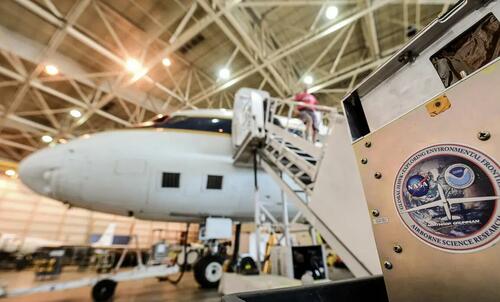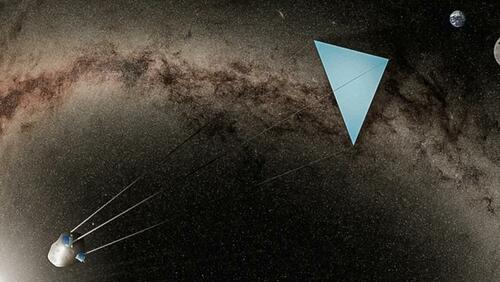In my previous post I warned about the madness of Climate Change. Well, here's what we are talking about.
To fight imaginary cataclysmic events we are about to unleash real ones.
Authored by Katie Spence via The Epoch Times (emphasis ours),
The Earth is too hot and only getting hotter, according to governments and global bodies such as the United Nations; and the efforts to reduce carbon dioxide aren’t having enough of an effect.
“The world is passing through the 1.5°C ceiling and is headed much higher unless steps are taken to affect Earth’s energy imbalance,” James Hansen, the previous director of the NASA Goddard Institute for Space Studies, warned in January.

Thus, to buy more time, on Feb. 28, scientists from NASA and the National Oceanic and Atmospheric Administration (NOAA) released a report detailing a solution called “intentional stratospheric dehydration,” or in layman’s terms, flying planeloads of ice to 58,000 feet and spraying ice particles into the upper atmosphere.
“It’s a very small effect,” said lead author Joshua Schwarz, a research physicist at NOAA’s chemical sciences laboratory. “Pure water vapor doesn’t readily form ice crystals. It helps to have a seed, a dust particle, for example, for ice to form around.”
The researchers report that by dispersing small particles, or what it calls ice nuclei, into areas of the atmosphere that are both “very cold and super-saturated with water vapor,” water vapor in the atmosphere will “freeze-dry” and rain out of the atmosphere as ice crystals, cooling the planet.
The proposal is known as geoengineering—and NASA and NOAA’s joint plan is far from the only idea that’s jumped from the pages of science fiction, à la the 2013 Hollywood film “Snowpiercer,” to mainstream science.
István Szapudi, an astronomer at the University of Hawaii Institute for Astronomy, has turned to essentially geoengineering a giant parasol, or what he calls, a “tethered solar shield” to shield the Earth from a portion of the sun’s energy.
“Any sunshield works by blocking a small fraction, circa 1–2 percent, of sunlight reaching Earth,” Mr. Szapudi told The Epoch Times. “This is an almost undetectable amount by looking at the sun, but it would still cool the atmosphere to pre-industrial temperatures according to climate models.
“Specifically, the tethered sun shield is a solution that is lighter, thus cheaper, by many orders than traditional designs.”
Technology entrepreneurs Luke Iseman and Andrew Song of Make Sunsets have already taken action and have been creating reflective, high-altitude clouds by releasing balloons full of sulfur dioxide (SO2) into the stratosphere, what they call stratospheric aerosol injection (SAI).
“With climate change rapidly transforming our world, it’s crucial that we prioritize action over words,” Make Sunsets states on its website.
“We believe that SAI is the immediate, necessary solution to cool the planet and buy us time to transition to a more sustainable future.”
But scientists such as Christopher Essex, emeritus professor of applied mathematics and physics at the University of Western Ontario and the former director of its theoretical physics program, said CO2 isn’t the driver of Earth’s warmer temperature and that such geoengineering measures are “extraordinarily dangerous.”
“I used to run a climate panel for the World Federation of Scientists,” he told The Epoch Times. “And we had one session where we presented on exactly why geoengineering is extraordinarily dangerous. It’s a crazy idea.”
Ian Clark, emeritus professor for the Department of Earth and Environmental Sciences at the University of Ottawa, echoed Mr. Essex.
“Geoengineering the climate is a very scary prospect,” he told The Epoch Times.
“It’s something that should be relegated to the fantasy realm and science fiction.”
The Oxford Geoengineering Programme defines geoengineering as “the deliberate large-scale intervention in the Earth’s natural systems to counteract climate change.”

Solar Shield
According to Mr. Szapudi, climate change is a looming threat, and greenhouse gases, such as CO2, are a driving cause of that threat.
He published a report on July 31, 2023, outlining his proposal for a tethered sun shield, what he calls solar radiation management.
“Solar radiation management (SRM) is a geoengineering approach that aims to reduce the amount of solar radiation absorbed by the Earth to mitigate the effects of climate change,” he wrote in his report.
“Two strategies proposed for SRM involve adding dust or chemicals to the Earth’s atmosphere to increase the reflected fraction of sunlight or reduce the incoming radiation from space with solar shades or dust.”
He’s advocating for a sun shield because he believes it is less risky.
When asked to comment on Mr. Essex’s claim that geoengineering is “extraordinarily dangerous,” Mr. Szapudi said: “Space-based geoengineering, especially if it is modular and reversible in design, carries less risk than Earth-based SRM injecting dust or chemicals into the atmosphere, and [it is] vastly less risky than doing nothing.
“Given what we know today and the known risks of climate change, a tethered sun shield near the L1 Lagrange point at 1.5 million kilometers from us would not present an obvious risk to Earth. The benefit is preventing and even reversing negative effects of climate change.”
NASA defines Lagrange points as “positions in space where objects sent there tend to stay put” because of oppositional gravitational forces. The agency has identified five such points.
Mr. Szapudi acknowledged that there could be unknown risks and said that his proposal would need to undergo a more detailed scientific study, followed by a preliminary engineering study.
“Such a study would specify the location, the design, the materials, etc., that are most suitable. At that point, a quantitative and thorough risk assessment can be done, and a decision can be made [on] whether to go ahead with the implementation,” he said.
“In general, any big project would go through many layers of risk, cost, and benefit analyses as the design shapes up, and any showstoppers identified would halt the project. Ultimately, only the most cost-effective and safest design, if any, will be implemented.”

But Mr. Essex, who built his first computer climate model in the 1970s and was chairman of The Global Warming Policy Foundation’s Academic Advisory Council, said part of the problem with a sun shield is that it looks at the climate from an engineering perspective instead of a scientific one.
“You might be able to generate some plausible argument for defining the actual parasol and getting into space,” he said. “But the part you don’t understand is how climate will respond to it.
“Because we’ve been pushing this propaganda as being able to solve a problem, it starts to appear like an engineering problem where you can do trial and error and see if it works or doesn’t work. But the climate problem is not an engineering problem; it’s a fundamental scientific problem. ... It’s much more subtle and complex.”
Mr. Essex explained that solar radiation travels through the atmosphere, and while some believe that radiation causes warming at that point, that’s not what’s happening. Instead, the shortwave radiation hits the Earth, which heats the surface, and then the ground radiates that energy as longwave radiation into the atmosphere, increasing temperature.
“With the parasol, they’re trying to control shortwave radiation,” Mr. Essex said. “And it’s an indirect way of controlling what goes on with the longwave, the infrared.
“People like to think the Earth is like a brick, and it’s getting too hot, so we need to cool it down—global boiling, that’s the slogan—well, that’s ridiculous. It’s just about hyping up anxiety and fear so the people will go along with things and not question what’s going on.
“There’s so much going on in the atmosphere. It’s complex, conductive, and turbulent.”
Balloons of Sulfur
Like a sun shield, reflective aerosols fall under the definition of solar radiation management. But unlike a sun shield, reflective aerosols aren’t modular or immediately reversible.
Read more here...

No comments:
Post a Comment